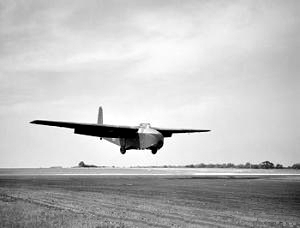General Aircraft Hamilcar
| GAL.49 Hamilcar | |
|---|---|
 |
|
| A Hamilcar Mark I in flight | |
| Role | Tank-carrying and heavy loads glider |
| Manufacturer | General Aircraft Ltd |
| First flight | 27 March 1942 |
| Introduction | 1942 |
| Primary users |
British Army Army Air Corps, Glider Pilot Regiment Royal Air Force |
| Produced | 1942-1946 |
| Number built | 344 |
The General Aircraft Limited GAL. 49 Hamilcar or Hamilcar Mark I was a large British military glider produced during the Second World War, which was designed to carry heavy cargo, such as the Tetrarch or M22 Locust light tank. When the British airborne establishment was formed in 1940 by the order of Prime Minister Winston Churchill it was decided to develop a large glider which would be able to transport heavy equipment in support of airborne troops. General Aircraft Limited were chosen in January 1941 to develop this glider, which they designated the GAL. 49 'Hamilcar'. It was designed to transport a single light tank or two Universal Carriers. A number of problems, which included vacillation by the War Office on the number of gliders that it wanted and poor management by GAL, led to delays in the production of the Hamilcar, and the first production glider was only assembled in mid-1943. These problems were only partially solved, and production of the glider continued to be slow, hampered by difficulties in finding suitable locations to store and construct the Hamilcars once their parts were produced. A total of 344 Hamilcars had been built when production ended in 1946.
Hamilcars were only used on three occasions, and only in support of British airborne forces. They first saw action in June 1944, when approximately thirty were used to carry 17-pounder anti-tank guns, transport vehicles and Tetrarch light tanks into Normandy in support of British airborne forces during Operation Tonga. In September 1944 a similar number of Hamilcars were used to transport anti-tank guns, transport vehicles and supplies for airborne troops as part of Operation Market Garden. They were used a third and final time in March 1945 during Operation Varsity, when they transported M22 Locust light tanks and other supplies. The gliders proved to be successful in all three operations, although their slow speed and large size made them easy targets for anti-aircraft fire, which resulted in a number of gliders being damaged or destroyed. A powered variant of the Hamilcar was produced, the Hamilcar Mark X, in an attempt to extend the range of the Hamilcar so it could serve in the Pacific War; however, the conflict in the Pacific ended before the design could see combat.
...
Wikipedia
